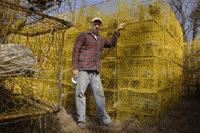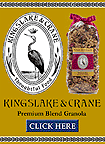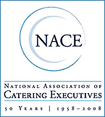
Maryland
Crab Season Opens to Anxiety
ANNAPOLIS, Md. -- The days are longer, the
water's warming up and waterman Don Pierce is readying his crab
rig in the yard, much as he has each spring since 1975, when
he started plying the Chesapeake Bay for the estuary's trademark
blue crabs.
But
there's an edge to Pierce this spring as he repairs the cabin
in the Bri-Steff, his 48-foot crab rig. Instead of looking forward
to retirement, Pierce is considering a new job because of what
is widely expected to be a lousy crab season on the Cheseapeake.
"I
feel like crying in my beer," said Pierce, who planned
to leave his Kent County home for the water Tuesday, the start
of Maryland's commercial crab season.
The
prognosis for the blue crab, the Chesapeake's hallmark seafood
product, is bad.
Last
year's catch was Maryland's second-lowest since 1945, and winter
population surveys indicate this year's harvest may not be much
better. Fishery regulators in Maryland and Virginia say the
crab population is nearing dangerous lows. Regulators are expected
to reduce the harvest even further to save crabs.
"Where
am I going to go to find a job at 59 years old?" Pierce
said. He doesn't know yet what the restrictions will be this
year, but he doubts they will be good. "This is going to
be devastating to us. To everybody."
From
Pierce's dock at the north end of the Chesapeake south to Virginia
waters to the mouth of the Atlantic Ocean, watermen can't stop
worrying about crabs. Neither can the picking houses that pack
crab meat for sale, or the dwindling number of restaurants that
still serve Chesapeake blue crab instead of relying on cheaper,
more reliable meat from the Gulf of Mexico or Asia.
The
worry extends to government scientists who manage the crab fisheries
in the Chesapeake. Maryland and Virginia scientists say they've
got one last shot to protect the crabs or they could face the
collapse of one of the region's last viable fisheries.
Annual
Maryland-Virginia surveys that project a census of the Chesapeake's
crab population show crabs have been down _ below 500 million
estimated to be living in the Chesapeake _ for 10 years straight.
As recently as 1993, the estimated crab population was more
than 852 million. This year's survey isn't complete yet, but
scientists working on it say there's little reason to believe
it will show the crabs have bounced back.
Lynn
Fegley, a fisheries biologist for the Maryland Department of
Natural Resources, spelled out possible restrictions to a crowd
of skeptical crabbers who packed a church basement in Annapolis
last month. The options Fegley laid out were aimed at protecting
adult female crabs _ called "sooks." Few went over
well.
The
ideas include a possible 6.5-inch size limit on female crabs.
A complete ban on catching female crabs could be imposed for
recreational crabbers. There is also likely to be a requirement
for crab pots to include an extra escape hatch for the smallest
juvenile crabs to escape.
Fishery
managers are trying to persuade crabbers that the Chesapeake's
blue crabs can be saved _ but only if everyone agrees to take
a financial hit for a few years.
"We
always give and give and give and never gotten nothin' back,"
said Sonny Norris of Baltimore County, a crabber who works out
of Essex. He, like many crabbers, says poor water quality and
habitat loss are to blame for the problem, not overharvesting.
"Anywhere
there used to be grass, it's parking lots now. And all that
stuff ends up in the Bay every time it rains," he said.
Regulators
don't disagree, but say crabbers are the easiest targets in
their efforts to increase crab numbers in the short term.
"We
all take a measure of responsibility for this," Bull said.
"But we're managing a fishery. We can't make the water
any cleaner. We can't make the grass grow. But we can reduce
the numbers of crabs we take out of the Bay."
Back
in Kent County in eastern Maryland, Pierce isn't sure what to
say when a supplier calls him asking how many crab pots he'll
need for the fall.
"What
am I supposed to tell him? That I have no idea what they're
going to do to us by then?" Pierce asked. "I do realize
that yes, we do have a problem. I realize that yes, it'd be
nice to keep 200 million spawning females in the estuary. The
problem is not the crabs, it's the human race."














